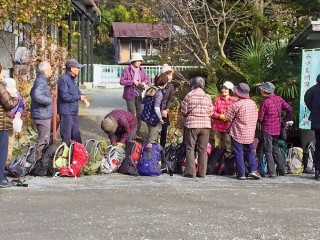Loading
Search
▼ Japan Is A Proving Ground For The Senior Market
- Category:Other
With the world’s grayest society, the country is becoming a preferred location to test new materials addressing the needs of the elderly
Toromi could well be the next Japanese word, like sushi or tsunami, to migrate into the English language. It basically means smoothness.
At a new lab that DuPont opened recently in Kawasaki, a suburb of Tokyo, researchers have been developing materials that provide toromi to food so it becomes easier to swallow. For the elderly, especially those at risk of accidentally inhaling food, toromi could be a lifesaver that helps prevent aspiration pneumonia, a potentially serious condition.
“We will develop food ingredients for the elderly, such as toromi enablers, to supply them to the Japanese market,” said Yongjing Li, DuPont Nutrition & Health’s regional president for Asia-Pacific, at an event to mark the opening of the Kawasaki lab. “And we will supply the solution to our Singapore, Thailand, and Chinese affiliates.”
DuPont is not the only company that sees Japan as the right place to develop products for the elderly; several other Western and Japanese firms are doing the same. Japan is often portrayed as a unique country with unique consumer products, but when it comes to aging, it may be just the place to design materials suited to global needs.
High longevity and a low birth rate make Japan the world’s grayest country. According to the population division of the United Nations, about one-third of Japanese are 60 or older, compared with a world average of 12%. For people 80 or over, the world average is less than 2%, but in Japan it is nearly 8%.
Advances in medical care, a national medical insurance scheme, healthy lifestyles, and effective systems for preventing disease all contribute to longer life in Japan. Meanwhile, the country accepts few immigrants, and the birth rate is at a record low. Women in Japan bear 1.4 children on average during their lifetimes, compared with 1.8 for women in the US.
BASF sees Japan as an innovation leader in nutrition and health—both for the elderly and consumers more broadly. “The Japanese pharmaceutical and food industries are big opportunities where we seek to create solutions, not only provide materials,” says Tomoyoshi Kajiura, the firm’s vice-director of pharma solutions, nutrition, and health. Using Japan’s new-product heritage and its strength in basic materials, BASF aims to develop such solutions in Japan and take them worldwide, he says.
One example is ibuprofen skin patches for pain relief. BASF is the world’s largest bulk manufacturer of the analgesic. Patch-delivered ibuprofen is easier on the liver, BASF says.
In the West, BASF supplies ibuprofen to customers that integrate it into pills, gels, and creams. Working with a Japanese health-care firm that it wouldn’t name, BASF developed graft polymers of polyethylene glycol and polyvinyl alcohol for an ibuprofen skin patch. Japan is the first country where BASF is supplying both ibuprofen and the materials needed to deliver it in a skin patch.
In its vitamin and food supplement business, BASF is also developing new products for Japan. Whereas consumers in the West tend to buy health supplements as stand-alone products, in Japan they are often added to drinks, jellies, yogurt, and even candies. “Japan is the best place to supply functional food that consumers can consume every day without feeling that they’re taking a pill,” Kajiura says.
The elderly, according to Kajiura, eat smaller portions than younger people and are thus more prone to store and reheat leftovers. Repeated heating or exposure to acidity caused by oxygenation can destroy the vitamin content of food.
“When we can offer powdered vitamins for packaged food that meet the needs of Japan’s elderly, it will be adopted worldwide,” Kajiura says.
BASF is designing other supplements that may address the needs of the elderly. One is a cholesterol-lowering plant sterol that can be added to food. The supplement is generally consumed in capsule form, but BASF is developing a powdered formulation designed for food.
“We will offer this to food and supplement manufacturers as a way for people to conveniently consume every day,” Kajiura says. “We will export this to the global market.”
Cosmetic companies are also using Japan as a base to develop products for global markets. According to Japanese government projections, 50% of Japanese women will be 50 or older by 2020. And industry research indicates that, compared with other countries, a higher proportion of older Japanese women use cosmetics than their counterparts in other countries.
In 2016, Pierre Fabre, a French cosmetic and drug company, opened an R&D facility in Tokyo—its only one outside France.
There, the firm designed Milky Gel Enrich, a personal care product that provides elasticity and tissue density to skin. It contains extracts of ascophyllum nodosum, a seaweed found in the Atlantic Ocean believed to have skin antiaging action.
“Japanese people think skin care is important and are sophisticated consumers of these products,” says Núria Perez-Cullell, CEO of Pierre Fabre Dermo-Cosmetics.
Pierre Fabre introduced Milky Gel Enrich in Japan last year, Perez-Cullell says, and sales so far are encouraging. The company may next launch it in other Asian countries where people have similar skin. Later, it will consider commercializing the product in Europe, she says.
As for DuPont, its global sales of nutrition and health-related products amount to about $4.5 billion annually, and Japan is the second-largest market for these products, coming after only the US. The company supplies Japan mostly by importing enzymes, proteins, and other nutrients made at DuPont facilities worldwide.
The recently opened Kawasaki lab will mainly develop products aimed at food for the elderly. In aging Japan, the market for such specialty foods is worth nearly $1.1 billion per year, according to DuPont. The company expects staffers at the lab to work with customers, government, and academia to develop unique food ingredients, such as those providing the toromi characteristic.
“We will introduce the solutions developed in Japan to the world market,” Kobus de Klerk, DuPont’s global innovation leader, said at the opening event. Similarly to Pierre Fabre, DuPont will likely launch its Japan-developed products in other Asian countries first. “Tastes in other Asian markets are similar to Japan,” DuPont’s Li said.
Japanese chemical companies are similarly expanding their range of products for the elderly. In the fall, Mitsui Chemicals launched a line of reading glasses. Mitsui is already the world’s largest manufacturer of monomers used to produce eyeglass lenses, with a 45% market share, but this is its first foray in the consumer market.
Called TouchFocus, the new line of glasses can improve both midrange and near vision, the firm says. Unlike with bifocals, users can adjust the focus of the entire lens from midrange to near vision without having to switch from one pair to another. The glasses are custom made and sell for ¥250,000 (about $2,300) a pair.
Mitsui expects to sell 50,000 pairs of TouchFocus glasses annually in Japan by 2020, according to Shinichi Hayase, the firm’s group leader for electronic eyewear business development. The TouchFocus glasses, which include some electronics initially developed by Panasonic for the US market, are made in Nagoya, Japan. Mitsui plans to sell the glasses in the rest of Asia and the US later on, Hayase says.
Planners at Mitsubishi Chemical, meanwhile, expect that aging will precipitate a change of emphasis in the food industry from manufacturing to storage and delivery. The company has observed that more and more food in Japan is delivered to homes. Similarly, convenience stores and supermarkets sell an increasing amount of ready-to-eat food.
Mitsubishi is widening its line of emulsifiers, sweeteners, biocides, and other additives for the food market to better serve these trends. It acquired Eisai Food & Chemical in 2015, a move that added amino acids, acetates, and lysozymes that can be used as additives to extend shelf life.
Mitsubishi has also strengthened its R&D for the food segment. The Eisai acquisition brought researchers and know-how that Mitsubishi has incorporated into its food research center in Yokohama. The company simultaneously added cooking capabilities to the center so researchers can test how their additives perform in real life.
Actually cooking food with new additives is an essential step, says Toshiya Katsuragi, who heads Mitsubishi’s high-performance chemical planning department.
Chemical companies from Japan and around the world are making the right choice in using the country as a testing ground for new products aimed at the elderly, according to Perez-Cullell. “Japanese consumers are demanding in terms of effectiveness, quality, ease of use, and other characteristics,” she says.
It’s still early days for Japan’s role as a proving ground for products for the aged, but encouraging early results at Pierre Fabre and other firms suggest that the country’s role in easing the lives of the elderly will continue to increase.
by Katsumori Matsuoka
- January 15, 2019
- Comment (0)
- Trackback(0)



